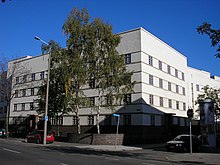Hanseviertel (Erfurt)
The Hanseviertel is a quarter in the Krämpfervorstadt district of the Thuringian capital of Erfurt . On December 31, 2007, 4,750 people lived in the Hanseviertel. This is where the Erfurt University of Applied Sciences is located . The Hanseviertel is characterized by avant-garde residential buildings from municipal housing from the 1920s and 1930s.
location
The Hanseviertel occupies the northern part of the Krmpfervorstadt. It extends between Leipziger Strasse in the south, Stauffenbergallee in the west, Schlachthofstrasse in the north and Greifswalder Strasse in the east. In the Hanseviertel itself are Wilhelmshavener Strasse, Helgoländer Weg, Rostocker Strasse, Oldenburger Strasse, Emdener Strasse, Bremer Strasse, Hamburger Strasse, Altonaer Strasse, Kieler Strasse, Flensburger Strasse, Liebknechtstrasse, Fritz- Noack-Strasse, Röntgenstrasse and Bodestrasse. Hanseplatz, Leipziger Platz and Steinplatz are on the edge of the district . The district is connected to local public transport via tram line 2 on Leipziger Strasse and city bus route 9 on Liebknechtstrasse.
history
From 1880 the front part of the Hanseviertel between Stauffenbergallee and Liebknechtstraße was built on. There is still some classic Wilhelminian style architecture with tenement houses from that time. The First World War stopped building activity in the Hanseviertel. After the First World War, Erfurt, as in other major German cities, was poor, paired with an oppressive housing shortage. This prompted the city administration to build communal apartments. For this purpose, the Bauhaus architects Karl Schneider and Otto Jacobsen from Hamburg were brought in , who already had experience there with the construction of contemporary municipal apartments. Jacobsen became a partner in the property company Krämpfertor mbH , which began building the Hanseviertel in 1928. The residential complexes "Flensburger Block" and "Hamburger Block", which were built until 1930, became the architectural flagship of the quarter. These are four-story apartment blocks in the Bauhaus-appropriate forms. For the first time, an external corridor was built on the Hamburg block in Erfurt. In 1946 the horticultural college was founded. It got its campus on Altonaer Strasse in the middle of the Hanseviertel, where the Erfurt University of Applied Sciences is now based. In the period shortly after the Second World War, the development of the Hanseviertel up to Greifswalder Strasse in the east was completed. After reunification, the residential area was redeveloped, the technical college was founded and expanded with additional buildings.
literature
- Mark Escherich: “Flensburger and Hamburger Block” residential complexes . In: Ulrich Wieler (Ed.): Architekturführer Thüringen 2 . Publishing house of the Bauhaus University, Weimar 2006, ISBN 3-86068-278-4 .
Web links
Coordinates: 50 ° 59 ′ 7 ″ N , 11 ° 2 ′ 26 ″ E
